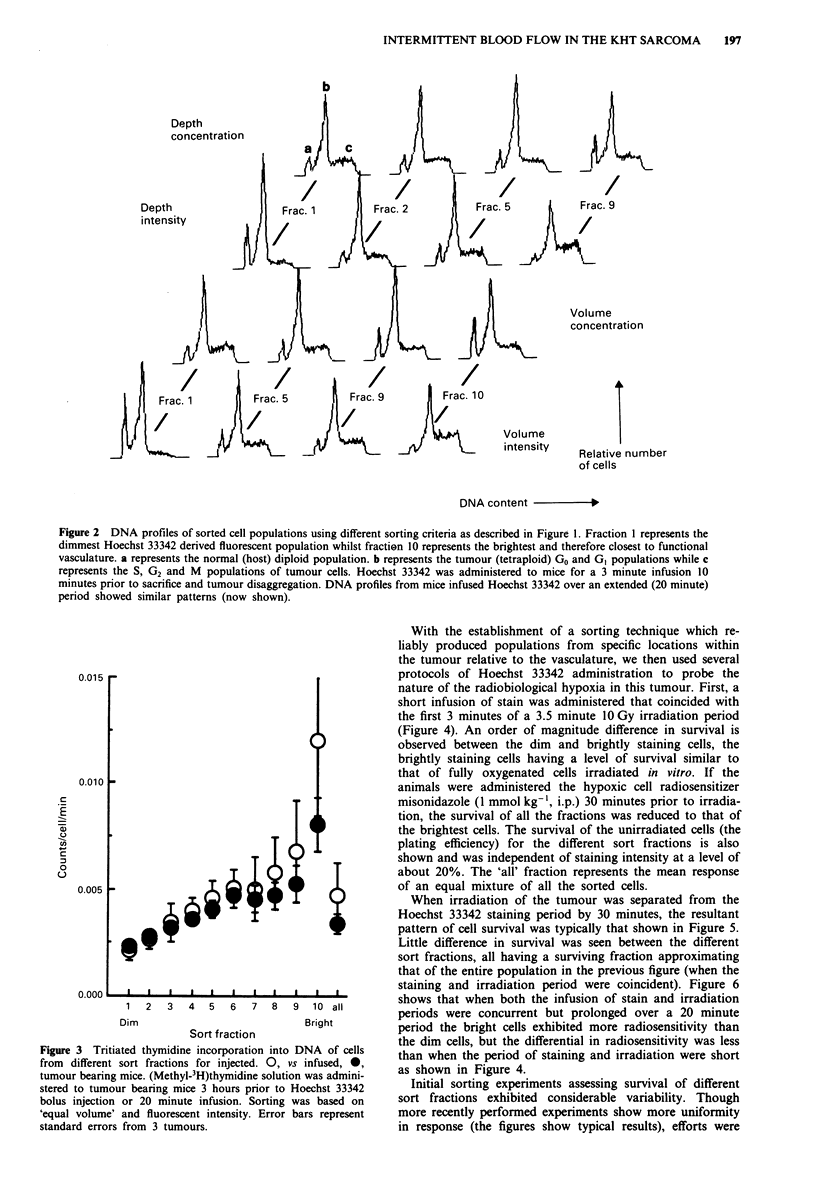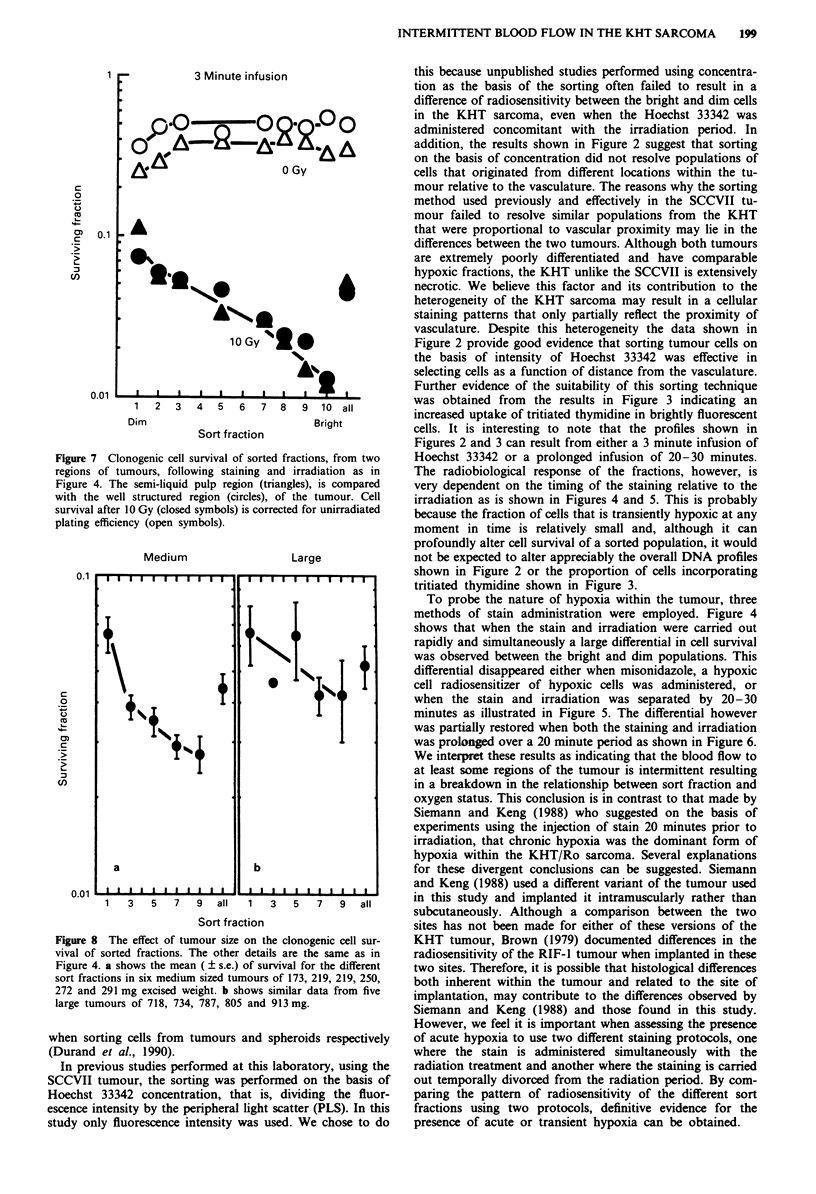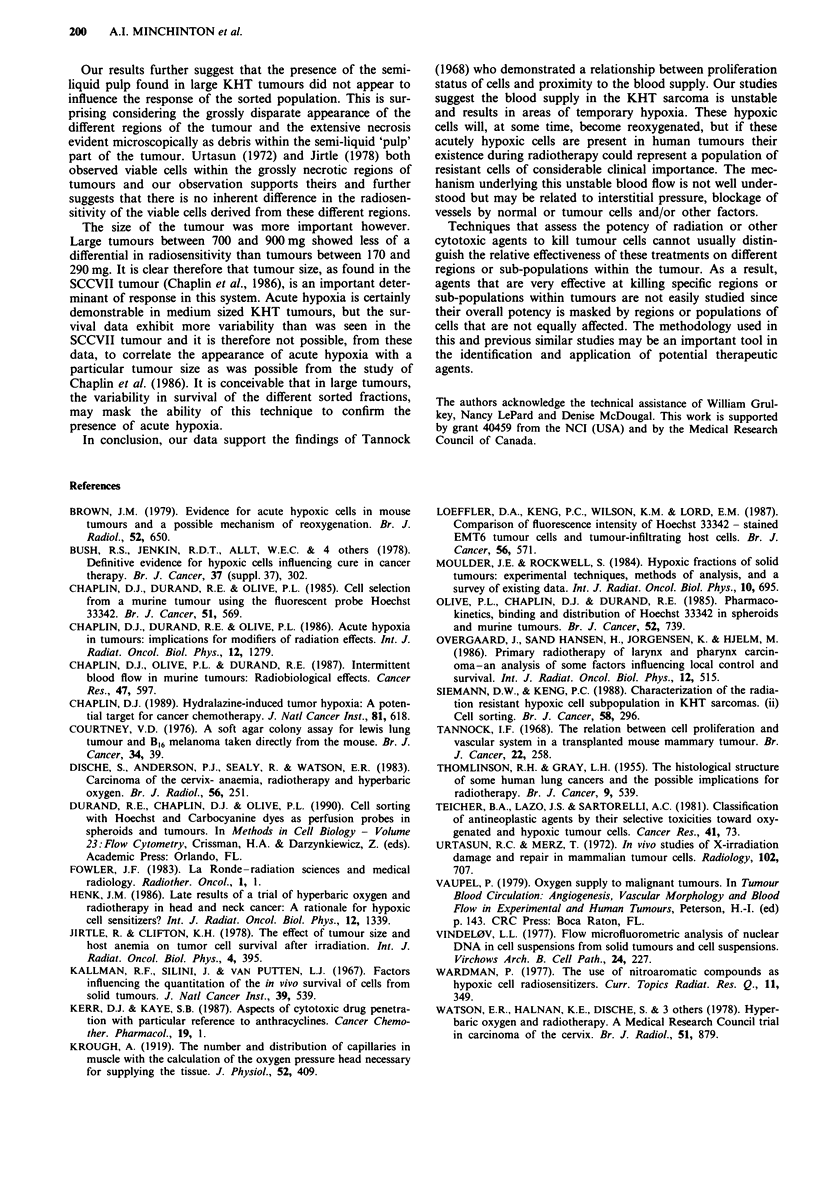Abstract
The administration of the fluorescent DNA stain, Hoechst 33342, to mice bearing the KHT sarcoma, combined with flow cytometry, can be used to select cells according to their proximity to functional vasculature. Different protocols of administration of Hoechst 33342 were used in order to differentiate between the presence of temporary and chronically hypoxic cells. The results show a large difference in radiosensitivity between cells close to, and distant from, functional vasculature. However, this pattern of radiosensitivity is observed only when the staining period with Hoechst 33342 is short and coincides with the period of irradiation. When the radiation treatment is temporally divorced from the staining period then the radiosensitivity and staining intensity are not related. This result can be interpreted as indicating that hypoxic cells exist within this tumour as a result of fluctuations in tumour blood flow.
Full text
PDF





Selected References
These references are in PubMed. This may not be the complete list of references from this article.
- Brown J. M. Evidence for acutely hypoxic cells in mouse tumours, and a possible mechanism of reoxygenation. Br J Radiol. 1979 Aug;52(620):650–656. doi: 10.1259/0007-1285-52-620-650. [DOI] [PubMed] [Google Scholar]
- Bush R. S., Jenkin R. D., Allt W. E., Beale F. A., Bean H., Dembo A. J., Pringle J. F. Definitive evidence for hypoxic cells influencing cure in cancer therapy. Br J Cancer Suppl. 1978 Jun;3:302–306. [PMC free article] [PubMed] [Google Scholar]
- Chaplin D. J., Durand R. E., Olive P. L. Acute hypoxia in tumors: implications for modifiers of radiation effects. Int J Radiat Oncol Biol Phys. 1986 Aug;12(8):1279–1282. doi: 10.1016/0360-3016(86)90153-7. [DOI] [PubMed] [Google Scholar]
- Chaplin D. J., Durand R. E., Olive P. L. Cell selection from a murine tumour using the fluorescent probe Hoechst 33342. Br J Cancer. 1985 Apr;51(4):569–572. doi: 10.1038/bjc.1985.79. [DOI] [PMC free article] [PubMed] [Google Scholar]
- Chaplin D. J. Hydralazine-induced tumor hypoxia: a potential target for cancer chemotherapy. J Natl Cancer Inst. 1989 Apr 19;81(8):618–622. doi: 10.1093/jnci/81.8.618. [DOI] [PubMed] [Google Scholar]
- Chaplin D. J., Olive P. L., Durand R. E. Intermittent blood flow in a murine tumor: radiobiological effects. Cancer Res. 1987 Jan 15;47(2):597–601. [PubMed] [Google Scholar]
- Courtenay V. D. A soft agar colony assay for Lewis lung tumour and B16 melanoma taken directly from the mouse. Br J Cancer. 1976 Jul;34(1):39–45. doi: 10.1038/bjc.1976.119. [DOI] [PMC free article] [PubMed] [Google Scholar]
- Dische S., Anderson P. J., Sealy R., Watson E. R. Carcinoma of the cervix--anaemia, radiotherapy and hyperbaric oxygen. Br J Radiol. 1983 Apr;56(664):251–255. doi: 10.1259/0007-1285-56-664-251. [DOI] [PubMed] [Google Scholar]
- Fowler J. F. The second Klaas Breur memorial lecture. La Ronde--radiation sciences and medical radiology. Radiother Oncol. 1983 Aug;1(1):1–22. doi: 10.1016/s0167-8140(83)80003-6. [DOI] [PubMed] [Google Scholar]
- Henk J. M. Late results of a trial of hyperbaric oxygen and radiotherapy in head and neck cancer: a rationale for hypoxic cell sensitizers? Int J Radiat Oncol Biol Phys. 1986 Aug;12(8):1339–1341. doi: 10.1016/0360-3016(86)90167-7. [DOI] [PubMed] [Google Scholar]
- Jirtle R., Clifton K. H. The effect of tumor size and host anemia on tumor cell survival after irradiation. Int J Radiat Oncol Biol Phys. 1978 May-Jun;4(5-6):395–400. doi: 10.1016/0360-3016(78)90068-8. [DOI] [PubMed] [Google Scholar]
- Kallman R. F., Silini G., Van Putten L. M. Factors influencing the quantitative estimation of the in vivo survival of cells from solid tumors. J Natl Cancer Inst. 1967 Sep;39(3):539–549. [PubMed] [Google Scholar]
- Kerr D. J., Kaye S. B. Aspects of cytotoxic drug penetration, with particular reference to anthracyclines. Cancer Chemother Pharmacol. 1987;19(1):1–5. doi: 10.1007/BF00296245. [DOI] [PubMed] [Google Scholar]
- Krogh A. The number and distribution of capillaries in muscles with calculations of the oxygen pressure head necessary for supplying the tissue. J Physiol. 1919 May 20;52(6):409–415. doi: 10.1113/jphysiol.1919.sp001839. [DOI] [PMC free article] [PubMed] [Google Scholar]
- Loeffler D. A., Keng P. C., Wilson K. M., Lord E. M. Comparison of fluorescence intensity of Hoechst 33342-stained EMT6 tumour cells and tumour-infiltrating host cells. Br J Cancer. 1987 Nov;56(5):571–576. doi: 10.1038/bjc.1987.243. [DOI] [PMC free article] [PubMed] [Google Scholar]
- Moulder J. E., Rockwell S. Hypoxic fractions of solid tumors: experimental techniques, methods of analysis, and a survey of existing data. Int J Radiat Oncol Biol Phys. 1984 May;10(5):695–712. doi: 10.1016/0360-3016(84)90301-8. [DOI] [PubMed] [Google Scholar]
- Olive P. L., Chaplin D. J., Durand R. E. Pharmacokinetics, binding and distribution of Hoechst 33342 in spheroids and murine tumours. Br J Cancer. 1985 Nov;52(5):739–746. doi: 10.1038/bjc.1985.252. [DOI] [PMC free article] [PubMed] [Google Scholar]
- Overgaard J., Hansen H. S., Jørgensen K., Hjelm Hansen M. Primary radiotherapy of larynx and pharynx carcinoma--an analysis of some factors influencing local control and survival. Int J Radiat Oncol Biol Phys. 1986 Apr;12(4):515–521. doi: 10.1016/0360-3016(86)90058-1. [DOI] [PubMed] [Google Scholar]
- Siemann D. W., Keng P. C. Characterization of radiation resistant hypoxic cell subpopulations in KHT sarcomas. (II). Cell sorting. Br J Cancer. 1988 Sep;58(3):296–300. doi: 10.1038/bjc.1988.207. [DOI] [PMC free article] [PubMed] [Google Scholar]
- THOMLINSON R. H., GRAY L. H. The histological structure of some human lung cancers and the possible implications for radiotherapy. Br J Cancer. 1955 Dec;9(4):539–549. doi: 10.1038/bjc.1955.55. [DOI] [PMC free article] [PubMed] [Google Scholar]
- Tannock I. F. The relation between cell proliferation and the vascular system in a transplanted mouse mammary tumour. Br J Cancer. 1968 Jun;22(2):258–273. doi: 10.1038/bjc.1968.34. [DOI] [PMC free article] [PubMed] [Google Scholar]
- Teicher B. A., Lazo J. S., Sartorelli A. C. Classification of antineoplastic agents by their selective toxicities toward oxygenated and hypoxic tumor cells. Cancer Res. 1981 Jan;41(1):73–81. [PubMed] [Google Scholar]
- Urtasun R. C., Merz T. In vivo studies of x-irradiation damage and repair in mammalian tumor cells. Radiology. 1972 Mar;102(3):707–708. doi: 10.1148/102.3.707. [DOI] [PubMed] [Google Scholar]
- Watson E. R., Halnan K. E., Dische S., Saunders M. I., Cade I. S., McEwen J. B., Wiernik G., Perrins D. J., Sutherland I. Hyperbaric oxygen and radiotherapy: a Medical Research Council trial in carcinoma of the cervix. Br J Radiol. 1978 Nov;51(611):879–887. doi: 10.1259/0007-1285-51-611-879. [DOI] [PubMed] [Google Scholar]


